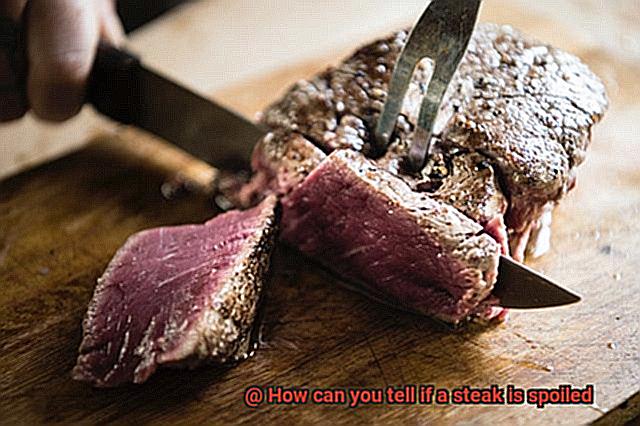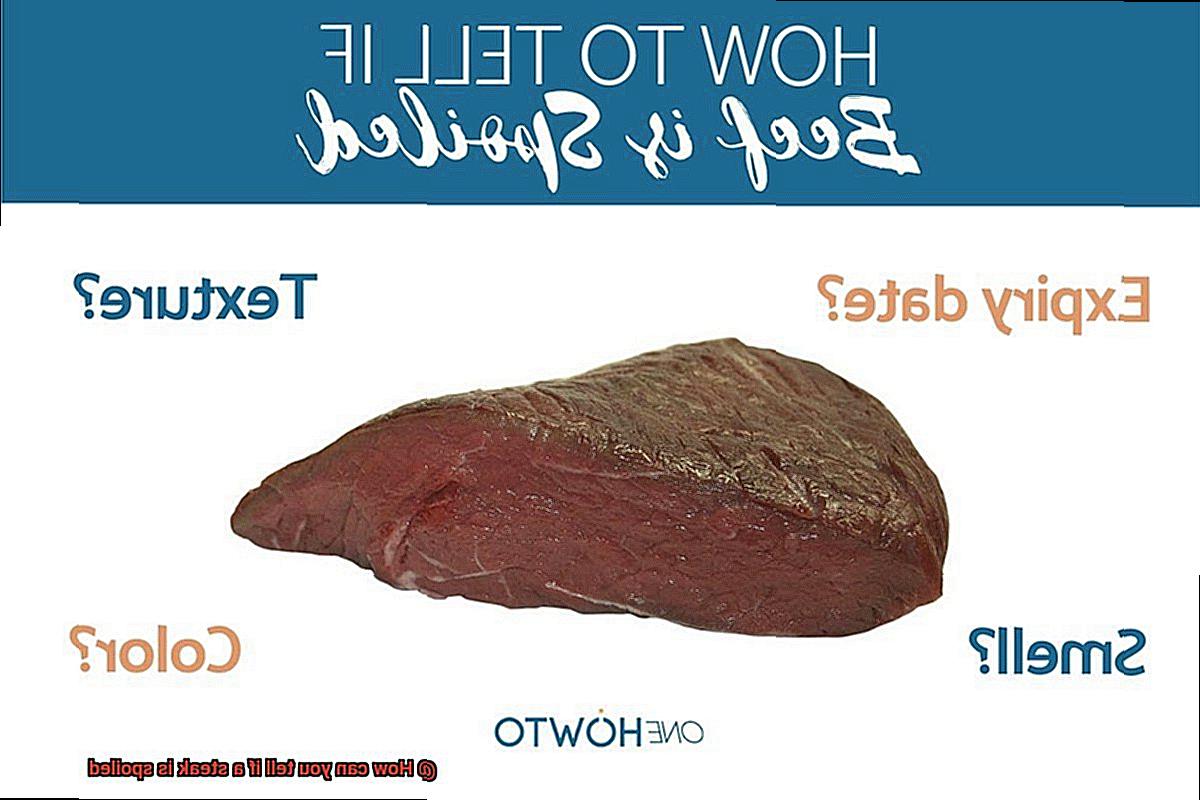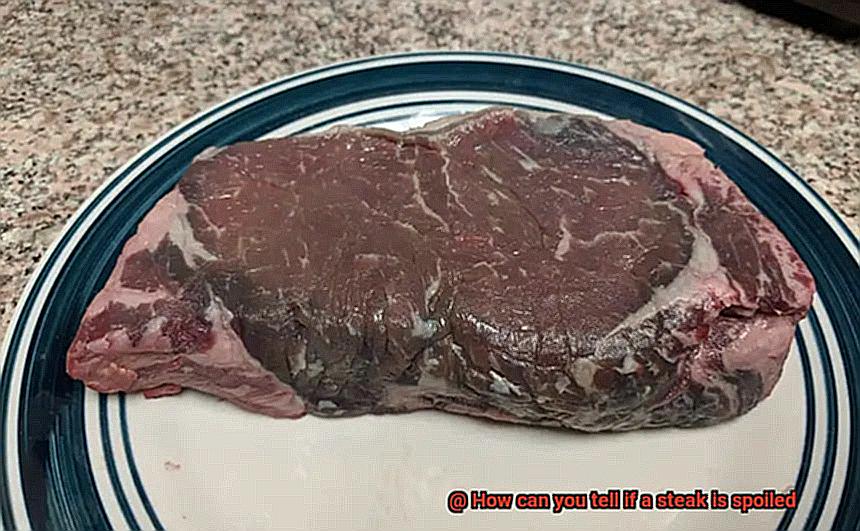Imagine this: it’s a special evening, and you’re all set to unleash your culinary prowess on a succulent steak dinner. You’ve seasoned it with care, seared it to perfection, and now it’s time to savor its tantalizing flavors. But hold on – how can you be absolutely certain that the steak you’re about to devour is fresh and safe? Don’t fret, my friend, because we’re about to embark on a journey that will equip you with the knowledge to confidently determine if a steak has gone bad.
Picture your taste buds and happiness being instantly crushed by a spoiled piece of meat. It’s every cook’s worst nightmare, and even the best of us can fall victim to it. But fear not. There are unmistakable signs that can prevent this gastronomic catastrophe from happening.
In this article, we’ll explore the key indicators that unveil the unsavory truth about a spoiled steak. We’ll dive deep into texture, color, and odor – exposing the secrets your senses have been quietly whispering all along.
First up, we’ll delve into the art of texture inspection. We’ll explore how touch and visual cues can reveal any abnormalities lurking within the meat. Then we’ll navigate through the often deceptive world of color, unraveling the various shades that may hint at hidden spoilage. Finally, we’ll arrive at the most critical sense for steak detection – our sense of smell. Get ready to decode those mysterious aromas and distinguish between the alluring scent of perfectly aged meat and the pungent stench of decay.
By the end of this captivating journey, you’ll emerge as a true steak connoisseur armed with wisdom to sniff out any spoiled steak that dares cross your path. So grab your aprons and prepare to unlock the secrets behind one of the most essential skills any steak lover should possess. The tantalizing world of steak is waiting to be explored – are you ready?
Contents
Appearance as an Indicator of Spoiled Steak
In the world of steak, appearances aren’t just for show. Did you know that you can actually determine if a steak is spoiled just by looking at it? This guide will take you on a journey through the fascinating world of steak appearance, where subtle changes in color, texture, smell, and even packaging can reveal the truth about spoilage. Get ready to decode the secrets hidden within your meat and ensure that every bite is both delicious and safe.
Color: The Art of Freshness:
Fresh steak dances with a vibrant, cherry-red hue, courtesy of the mighty myoglobin protein. But as time passes, the colors change. Gray or brown shades hint at spoilage, while green or yellow discoloration screams bacterial invasion. Keep your eyes peeled for these visual cues to make informed decisions about your steak’s freshness.
Texture: A Touch of Decay:
Spoiled steak doesn’t just feel wrong – it feels downright slimy or sticky. Fresh meat should greet your touch with firmness and a slight moisture. However, when bacteria party on the surface, they leave behind a slimy film that signals trouble. Trust your tactile senses to ensure that your steak passes the touch test.
Odor: The Fragrant Truth:
Your nose knows what’s up when it comes to spoiled steak. Fresh cuts offer a neutral or subtly metallic aroma. But if foul or peculiar scents waft from your meat, it’s time to sound the alarms. These olfactory disturbances often indicate bacterial growth or decomposition processes that have run amok.
Mold: Uninvited Guests:
Mold may be welcome in some corners of culinary exploration, but not on your precious steak. Its presence signifies prolonged exposure to moisture and air – an open invitation for mold spores to thrive. Should you spot fuzzy patches or greenish-blue splotches on your steak, bid it farewell without hesitation.
Packaging: The First Impression:
Even before you lay eyes on the steak itself, the packaging can offer valuable hints about spoilage. Tear, leaks, or bulges in the wrapping speak volumes about potential compromises. These vulnerabilities allow bacteria to infiltrate and spoil your meat, so pay attention to the visual cues from the packaging.
Texture of Spoiled Steak
Imagine the anticipation of sinking your teeth into a juicy, perfectly cooked steak, only to be met with disappointment and a wave of nausea because it has gone bad. Fear not, for today we will explore the intriguing world of spoiled steak textures. Armed with this knowledge, you’ll confidently identify and avoid any meat mishaps. Let’s embark on this flavorful journey.
Texture Indicator #1: Slimy or Sticky
Have you ever touched a piece of steak that made you recoil at its slimy or sticky texture? That’s a surefire sign of spoilage. When bacteria multiply on the meat’s surface, they produce a slimy film that leaves a slippery residue on your fingertips. If your steak feels more like a slippery eel than a succulent delight, it’s time to bid it farewell.
Texture Indicator #2: Dry or Tough Consistency
Picture taking a bite of steak and feeling like you’re chewing on a rubber eraser. Not appetizing, right? When meat starts to spoil, it loses moisture, resulting in a dry and tough consistency. No amount of marination or tenderizing can salvage the unfortunate fate of a dry steak. Unless you’re aiming for an impromptu jaw workout, it’s best to steer clear.
Texture Indicator #3: Mushy or Soft
Ah, the dreaded mushy steak. It’s a texture that no carnivore wants to encounter. This unfortunate phenomenon occurs when meat is stored at improper temperatures for too long. The proteins break down, leaving you with a distressing mushy or soft texture that simply screams “avoid me.” Trust me; your taste buds will thank you for heeding this warning.
Texture Indicator #4: Grainy or Gritty
Ever sink your teeth into a steak only to feel an unexpected crunch? That’s not the delightful caramelization of a well-seared steak; it’s freezer burn. Freezer burn occurs when meat is exposed to air for too long, causing moisture loss and oxidation. The result? A grainy or gritty texture that leaves you questioning your culinary choices. If your steak feels like it’s been transformed into a sandy beach, it’s time to bid adieu.
Smell of Spoiled Steak
Today, we’re delving into the captivating realm of the smell of spoiled steak. Prepare yourself for a tantalizing exploration of the scents that warn us when our beloved steak has taken a turn for the worse. Get ready to become a connoisseur in the art of detecting the foul odors emanating from spoiled steak.
Let’s begin with the essence itself: the smell. As a steak starts to spoil, it unleashes an unpleasant and putrid odor that leaves no room for doubt. Imagine a medley of sulfur and ammonia permeating the air, assaulting your senses with its pungency.
But what causes this offensive stench? It all boils down to the breakdown of proteins within the meat. As these proteins deteriorate, they release an array of compounds, including volatile organic compounds (VOCs), responsible for the nauseating aroma that accompanies spoiled steak.
Now, here’s a crucial fact: not all spoiled steaks will assail your nostrils with an overpowering odor. Sometimes, the scent may be faint or masked by other surrounding smells. So how can you determine if your steak has reached its expiration date? Trust your sense of smell.
Start by taking a good whiff of your steak. If it exudes a rancid, putrid, or anything other than fresh and meaty scent, consider it a clear indication that decay has set in. Your senses are sounding the alarm, urging you to avoid a potentially gut-churning experience.
However, relying solely on smell may not always suffice. Occasionally, even when a steak lacks a potent odor, it may still be spoiled. This is especially true if the meat has been stored improperly or for an extended period. In such cases, it’s wise to employ additional methods to ascertain its edibility.
Inspect the steak for any changes in color or texture – sliminess, stickiness, or dryness and toughness are all red flags signaling spoilage. And if uncertainty persists, don’t hesitate to seek guidance from a professional. An experienced butcher or chef can provide invaluable advice to help you make an informed decision.
Remember, the smell of spoiled steak remains a reliable indicator of spoilage, but it’s not infallible. Trust your olfactory senses, use your other senses as reinforcement, and when in doubt, rely on the expertise of those well-versed in the ways of meat.
Taste of Spoiled Steak
In this chapter, we delve into the depths of its flavor, exploring the distinct sensations that serve as warning signs. Prepare yourself for an exhilarating adventure that will equip you with the knowledge to discern between culinary delight and potential disaster.
The Initial Warning Signs: Sour and Acidic Flavors
As you cautiously take that first bite of a spoiled steak, brace yourself for an onslaught of sour and acidic notes assaulting your taste buds. It’s as if the meat has transformed from a succulent delight into a tangy nightmare, leaving an unmistakable sensation that screams “Beware.”
This taste is often accompanied by a repugnant odor, serving as a grim reminder to proceed with utmost caution.
A Flavor Gone Wrong: Bitterness and Metallic Undertones
As the proteins within the meat undergo their inevitable breakdown during spoilage, an unwelcome transformation occurs – bitterness emerges from its depths. Spoiled steak leaves behind a lingering metallic flavor that coats your mouth like a haunting specter, shattering any hope of a palatable experience.
This bitter reminder of the meat’s deterioration compels you to cast it aside and retreat from its clutches.
A Texture Nightmare: Slimy and Sticky Revelations
Just when you thought the ordeal couldn’t get any worse, spoiled steak reveals its true nature through its texture. Imagine sinking your teeth into a slimy or sticky piece of meat – it’s akin to stepping into a horror movie that unfolds right in your mouth.
This repulsive sensation serves as an ominous sign of bacterial growth and decomposition, urging you to bid farewell to your once-beloved steak.
Remember:
While these taste changes undoubtedly act as reliable indicators of spoiled steak, it’s crucial to acknowledge that individual tolerance levels may vary.
Some intrepid souls may possess a higher threshold for spoiled meat, while others are more sensitive to even the slightest alteration in taste. However, why take unnecessary risks when it comes to your health and culinary enjoyment?

Expiration Date for Assessing Freshness
Title: The Expiration Date Dilemma: Unlocking the Secrets of Freshness for Your Steak
Introduction:
Welcome back, fellow food enthusiasts. Today, we embark on a tantalizing journey into the world of expiration dates and their critical role in assessing the freshness of our beloved steaks. Prepare to be amazed as we unravel the secrets behind those elusive numbers. So put on your aprons, sharpen your knives, and let’s dive right in.
The Power of Expiration Dates:
Imagine standing in front of a supermarket shelf, staring at rows of mouthwatering steaks. How do you know which one is fresh and safe to consume? Enter the expiration date, a small but mighty tool that guides us on our culinary adventures. It’s a beacon of knowledge, providing a recommended timeline for savoring the meat at its peak deliciousness.
A Quest for Excellence:

We all strive for excellence in our lives, whether it’s in our work, relationships, or fashion choices. The same principle applies to our steaks. By honoring the expiration date, we ensure that every bite is an experience of unparalleled quality. Think of it as treating yourself to a gourmet delight with each mouthful.
The Perils of Ignoring Expiration Dates:
Picture this: you’re ready to indulge in a sumptuous steak dinner, but you ignore the expiration date on the packaging. You take a bite, oblivious to the potential dangers lurking within. Little do you know that your gamble could result in foodborne illnesses like salmonella or E. coli. It’s a risk not worth taking.
Safety First, Always:
In the realm of culinary safety, the expiration date reigns supreme. Manufacturers and retailers have meticulously determined these dates to protect our well-being. So let’s heed their advice and prioritize safety above all else. It’s a small gesture that ensures our dining experiences are filled with delight, not regret.
The Art of Deception:
Our senses can be deceptive. That visually appealing steak or its enticing aroma might tempt us, but remember, looks can be deceiving. The expiration date is the ultimate truth-teller, exposing any hidden dangers that our senses may fail to detect. Don’t let your taste buds lead you astray – trust the expiration date.
Storage Conditions and Assessing Freshness
Prepare to embark on a culinary adventure where we unravel the secrets of storing and assessing the freshness of your beloved steaks. As an expert in all things juicy and tender, I am here to guide you through this tantalizing journey. Let’s dive in and unlock the key to a perfectly fresh steak.
Mastering Storage Conditions: A Symphony of Freshness
Temperature Control: The Maestro of Preservation
In the grand orchestra of steak storage, temperature control takes center stage. Keep your raw steaks cool, my friends. Below 40°F (4°C), to be precise. This virtuoso move slows down bacterial growth and preserves the pristine freshness we crave. Remember, your refrigerator is the virtuoso’s instrument of choice for this symphony.
Shielded from the Elements: Packaging as Armor
Steaks need protection from the world around them. Encase them in airtight packaging or containers to ward off unwanted exposure to air and moisture. This not only maintains their quality but also ensures they don’t mingle with other flavors in your culinary symphony.
Strategic Placement: Separating Harmony from Chaos
To achieve harmony in your refrigerator, store raw steaks on the lower shelves, far away from ready-to-eat delicacies. We don’t want any accidental contamination from those delectable meat juices, do we?
Assessing Freshness: An Ode to Your Senses
A Visual Sonata: The Rhapsody of Color
Behold the visual feast that is a fresh steak. Its vibrant reddish hues dance with delight, untouched by discoloration or browning. Turn a blind eye to green or gray patches – they are but sour notes signaling spoilage.
Olfactory Symphony: The Fragrance of Perfection
Breathe in the intoxicating scent of a fresh steak – a delicate balance of sweetness and metallic allure. But beware the dissonant chords of ammonia or sulfur, for they herald the demise of freshness.
Tactile Harmony: Melodies in Texture
Engage your senses with a gentle caress of your steak. A fresh cut should yield a firm yet slightly springy touch, inviting you to savor its tenderness. Reject any slimy or sticky sensations, as they signify bacterial growth and spoilage.
The Dangers of Consuming Spoiled Meat
As we savor the tantalizing flavors and textures of perfectly cooked steaks, it is imperative that we recognize the lurking perils within. So, don your aprons, sharpen your senses, and embark on this journey to protect our health.
The Bacterial Culprits:
Imagine succulent roasts teeming with E. coli, juicy burgers infested with Salmonella, and tender steaks laced with Campylobacter. These vile bacteria eagerly await their chance to wreak havoc on unsuspecting digestive systems, all concealed in spoiled meat.
Food Poisoning and its Symptoms:
Prepare yourself for the aftermath of consuming spoiled meat: a dreadful bout of food poisoning. Nausea, vomiting, diarrhea, abdominal pain, and fever crash your culinary party, sounding the alarm that something has gone terribly awry in the kitchen.
Vulnerable Populations at Risk:
But let us not forget the amplified consequences for vulnerable populations – children, the elderly, pregnant women, and those with weakened immune systems. For them, the dangers of consuming spoiled meat can be even more severe. Their health demands our utmost vigilance in ensuring freshness and safety.
Cooking Doesn’t Always Save the Day:
Beware the fallacy that cooking will vanquish all dangers. Certain bacteria produce steadfast toxins that withstand scorching temperatures. So even if your spoiled steak is cooked to perfection, it may still harbor threats to your well-being.
The Silent Threat: Botulism
Now, let us delve into the depths of an insidious bacterium known as Clostridium botulinum. This cunning foe unleashes botulism upon consumption of its toxin-laden spoils. Brace yourself for muscle weakness, paralysis, difficulty breathing, and, in dire circumstances, death. A truly terrifying fate.
Safe Storage and Handling: Your Defense Against Spoilage
To ward off these perils, we must master the art of proper meat storage and handling. Refrigerate your meats at optimal temperatures, ensuring separation from other foods to halt the spread of contamination. And remember, diligent inspection of expiration dates is paramount.
WOrDQEAFFgQ” >
Conclusion
Determining whether a steak is spoiled is crucial for ensuring food safety and avoiding unpleasant dining experiences.
By using your senses, you can easily detect signs of spoilage. Start with a visual inspection: look for any discoloration, such as gray or green patches, or an off-putting slimy film.
Lastly, give it a gentle touch – if the texture feels sticky or mushy, that’s a clear indication of spoilage.






